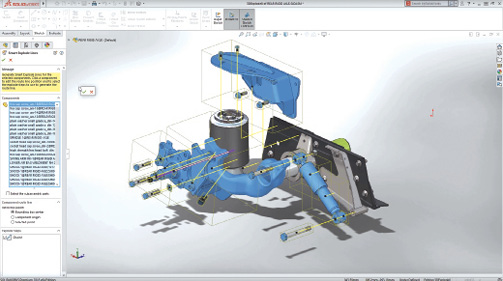
Smart Explode Lines in SOLIDWORKS 2018 saves manual work by creating automatic explode lines.
Latest News
March 1, 2018
Dassault Systèmes recently began shipping SOLIDWORKS 2018, the 26th release of the company’s parametric, feature-based solid modeling software. The new version delivers more than 200 new features and improvements across all aspects of the software, most created in direct response to customer requests.
The changes in SOLIDWORKS 2018 are evident as soon as the program starts. A new Welcome dialog provides a convenient way to open documents, view folders and access resources. The dialog has four tabs—Home, Recent, Learn and Alerts—and can be accessed at any time by clicking the Home button on the standard toolbar.
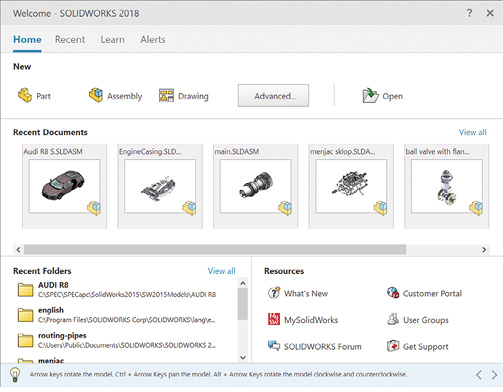 A new Welcome screen provides a convenient way to open documents, view folders and access resources.
A new Welcome screen provides a convenient way to open documents, view folders and access resources.Changes to the interface don’t end there, however. Mouse gestures, first introduced in SOLIDWORKS 2010, enable users to execute a command or macro by right-clicking and dragging the mouse in the graphics area to display a wheel-like menu. In previous releases, the number of possible gestures was limited to four or eight, and customizing gestures was often cumbersome. Now, SOLIDWORKS 2018 users can set the number of mouse gestures to two, three, four, eight or 12, and assigning commands to mouse gestures is quite easy with a drag-and-drop user interface. You can drag tools from a list of commands onto one of four mouse gesture guides, enabling users to quickly configure different mouse gestures when working on a part, assembly, sketch or drawing. Drag-and-drop also can be used to reposition tools or remove tools from the wheels.
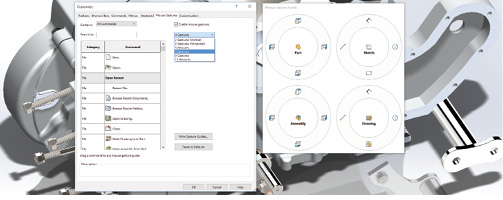 Changes to the Customize dialog make it extremely easy to customize mouse gestures.
Changes to the Customize dialog make it extremely easy to customize mouse gestures.Touch-based interactions represent a third major user interface enhancement. With the latest Windows 10 Creators Update, more users can take advantage of touch. When touch is turned on, a toolbar of commonly used tools appears and the program optimizes the size of on-screen manipulators and other tools. Sketch with your finger (or a stylus), and when used in conjunction with Auto Sketch Entities, the software analyzes the rough sketch and automatically converts it into sketch entities without having to preselect the type of entity to draw.
Native Files and Model Display
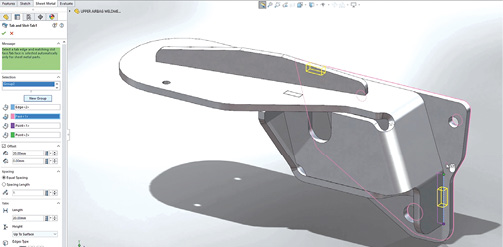 The new Tab and Slot feature lets users create self-fixturing parts.
The new Tab and Slot feature lets users create self-fixturing parts.3D Interconnect, first introduced in SOLIDWORKS 2017, replaced the software’s previous translation capabilities with new technology and workflows for working with third-party native CAD data. It enabled users to insert files saved using other programs directly into assemblies as they would any SOLIDWORKS file. Then, they are treated like native components, and designs can be easily updated when those CAD files change. That first iteration supported files created in CATIA, Inventor, Pro/Engineer, Creo, Solid Edge and NX. With SOLIDWORKS 2018, 3D Interconnect now supports STEP, IGES, ACIS and JT files as well. In addition, the software can read additional information from native third-party files, such as assembly cut features, custom properties, material properties and unconsumed sketches and curves.
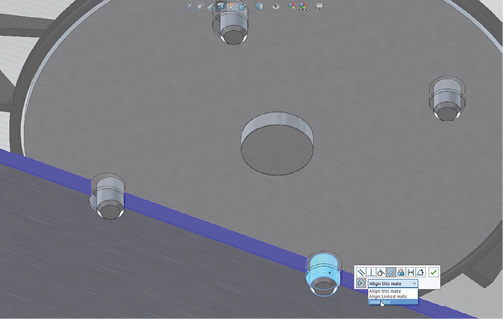 Create misaligned concentric mates and choose how to resolve imperfect conditions.
Create misaligned concentric mates and choose how to resolve imperfect conditions.SOLIDWORKS 2018 also introduces ways to use data from other sources, including mesh data in a variety of formats, such as STL and OBJ. The new Surface from Mesh feature lets users quickly select faces from mesh data and turn them into surfaces. Users also can turn mesh data into a new mesh body type and then add SOLIDWORKS features and geometry.
When opening an assembly, the program now shows a progress indicator that provides information about what is happening while the assembly is opening, including how long it is taking, the number of parts and how many have opened. In addition, the Assembly Visualization tool helps troubleshoot assembly performance. For example, you can view the open and rebuild times for components, and the total number of graphics triangles for all instances of components.
If SOLIDWORKS 2018 encounters a corrupted file that it is unable to repair, the software now prompts with an option to extract geometry if the body data of the file is still intact. After the software imports the geometry from the corrupted file into a new file, the geometry can be used to add features to create a new model, although the new file will not contain any feature history.
Parts, Features, Sheet Metal and Drawings
The Bounding Box tool in SOLIDWORKS was previously limited to cut list items in weldments. In the new release, users can now also create a bounding box around a single body or multi-body part or a sheet metal part. The resulting bounding box encloses the model with a minimum volume. For irregularly shaped objects, align the bounding box with a reference plane or reference surface. When the part updates, the bounding box automatically resizes. Users can include hidden bodies and surfaces in the bounding box as well as hide, show, suppress and unsuppress a bounding box from a shortcut menu.
Bounding box properties are available in the Configuration Specific tab of the Summary Information dialog. The dimensions of these properties can help determine the space required to ship and package a product.
Sheet metal improvements include a new Tab and Slot feature that creates tabs on one body and slots on another to interlock the two bodies. Tabs and slots make it easier to weld parts together and minimize the requirement to build complicated fixtures because users can interlock several parts. But tabs and slots are not limited to just sheet metal; use this feature in single bodies, multibodies and parts in the context of an assembly. Edges and faces must correspond to each other—when selecting an edge for the tabs, select a matching face for the slots. The edges and faces must be planar or cylindrical, but they do not have to touch.
 Smart Explode Lines in SOLIDWORKS 2018 saves manual work by creating automatic explode lines.
Smart Explode Lines in SOLIDWORKS 2018 saves manual work by creating automatic explode lines.Other sheet metal enhancements include a new Normal Cut feature, which ensures that proper clearances are maintained for manufacturing, and improvements to three bend corner reliefs. If a corner relief is smaller than the required corner cutout, it is now visible in the folded state. And, now there is the ability to create a suitcase corner—a closed spherical corner without any cutouts.
Drawing enhancements include the ability to insert 3D model views, automatic advanced hole callouts, layer support for cross hatching, new trailing zero display options, broken-out section view support for section views and alternate position views and an All Upper-Case switch capability for text in tables.
Sketching and Assembly Features
When sketching, now there’s a capability to mirror a 3D sketch about a plane or a planar face. In addition, 2D sketches can now be mirrored using a plane or a planar surface, and this capability is not limited to just linear entities such as lines or edges. When creating a linear component pattern, now there’s an option to add rotation. It is also now much easier to add mates between hidden surfaces: press the ALT key to temporarily hide obstructing faces when selecting mates, so that faces behind them can be seen and selected.
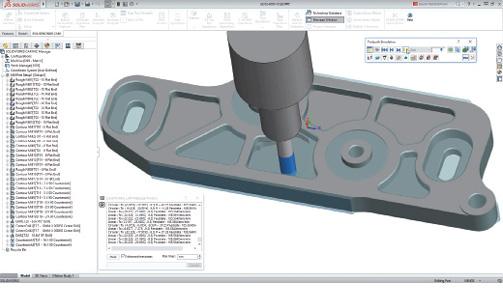 SOLIDWORKS 2018 includes SOLIDWORKS CAM Standard, providing rules-based 2.5-axis milling and turning to generate NC code and preview cutter paths.
SOLIDWORKS 2018 includes SOLIDWORKS CAM Standard, providing rules-based 2.5-axis milling and turning to generate NC code and preview cutter paths.If you encounter a situation where pins and holes are not perfectly aligned, you can define misaligned mates, which allows the option to specify which of the two concentric mates is maintained, or the part can float symmetrically between the two.
SOLIDWORKS 2018 also includes Smart Explode Lines, which lets users create automatic explode lines, eliminating manual steps. And those who have customized SOLIDWORKS will benefit from a new Login option that enables users to synchronize settings between any SOLIDWORKS 2018 installation with a copy of the settings stored in their online account. Online licensing is available regardless of whether users are on subscription; they can switch between online and standard activation if they wish.
Improvements in Other Modules
Although these enhancements are available to all users, other new features apply only to specific bundles and some add-ons are only included in those bundles for customers on an annual maintenance subscription. Otherwise, they cost extra. In addition, although Dassault Systèmes continues to sell SOLIDWORKS as a perpetual license, the company also now offers term licensing.
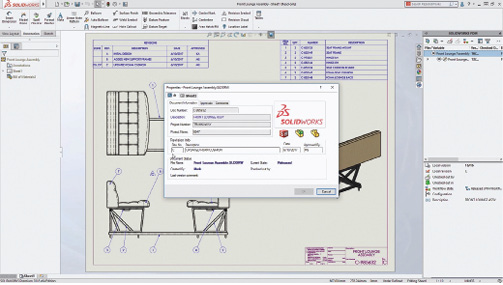 SOLIDWORKS PDM Standard enables management of design alternatives and manages revision updates.
SOLIDWORKS PDM Standard enables management of design alternatives and manages revision updates.As was true for previous releases, SOLIDWORKS is available in three flavors: Standard, Professional and Premium. SOLIDWORKS Standard ($3,995) provides tools for part and assembly modeling (including sheet metal, weldments, plastic parts and mold design), creating 2D drawings, sharing CAD data (including 3D Interconnect), the ability to perform static and stress analysis on parts and so on.
New to SOLIDWORKS 2018 Standard is SOLIDWORKS CAM Standard. Powered by CAMWorks, SOLIDWORKS CAM Standard provides 2.5-axis rules-based machining and automatic feature recognition to streamline NC programming. Cutter paths can be previewed and compared against the original model, helping users identify potential problems long before the physical part is machined. Those not on subscription can purchase CAM Standard for $1,000. The Pro version, which provides additional capabilities beyond 2.5-axis milling and turning, costs $2,400.
SOLIDWORKS Professional ($5,490) adds modules such as photorealistic rendering, parts libraries, task scheduling, reverse engineering, cost estimating and ECAD collaboration (CircuitWorks). It also includes eDrawings Professional, which allows users to send SOLIDWORKS files to people who do not have SOLIDWORKS, giving them the ability to open, measure and markup files.
The Professional edition also includes SOLIDWORKS PDM Standard, which offers data management capabilities for small numbers of users. For 2018, new branch and merge capabilities enable users to explore design ideas. Parts, assemblies or drawings can be branched and individual files then included or excluded as one studies alternatives. When deciding on the preferred design, it can be merged back. Revision tables are integrated so that as a new revision is added, the revision number is controlled by the software. When a drawing is checked in, all information is extracted from the drawing, including information from the revision table. When approved, the revision table, revision callouts and title block are all updated. Again, SOLIDWORKS PDM Professional, which provides more full-featured data management capabilities for larger design teams, is sold separately.
SOLIDWORKS Premium ($7,995) includes everything in the Standard and Professional editions and adds motion analysis; structural part and assembly analysis; and routing for pipes, tubes, cabling and wire harnesses. One component in particular—SOLIDWORKS Simulation—sports a host of new features, including Topology studies (the ability to set a design goal to find the best strength to weight ratio, minimize the mass or reduce the maximum displacement of a component) and automatic email notification when an analysis is complete.
The company has also improved various add-ons not included in bundles. For example, Offloaded Rendering (part of Visualize Professional or available separately for $995), enables users to send a rendering to another machine running the PhotoView 360 Net Render Client, freeing up the computer while the rendering is performed on another machine. The second system does not require a SOLIDWORKS license. One can perform a single offloaded rendering or schedule offloaded renderings to run later, such as after business hours.
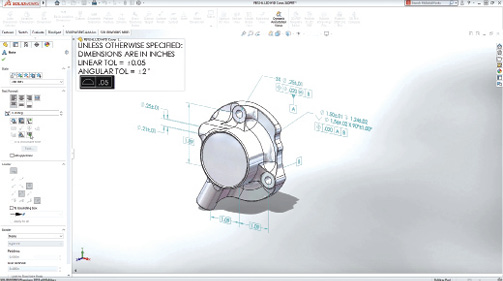 Model Based Definition can eliminate the need for 2D drawings.
Model Based Definition can eliminate the need for 2D drawings.Model Based Definition ($1,995)—which lets users communicate product and manufacturing information directly in 3D, eliminating the need for 2D drawings—has gained new capabilities, such as applying datum features to patterns. It can also now import parts with 3D annotation from other CAD systems such as Creo, NX and CATIA as well as STEP AP242. Exporting to STEP AP242 is also now fully supported, enabling third-party applications to reuse the intelligent annotations generated in SOLIDWORKS MBD.
All told, SOLIDWORKS 2018 marks one of the most significant releases in years. It continues to stack up well against competing products in what is perpetually a very competitive market segment.
More Info
SOLIDWORKS 2018
Pricing:
- SOLIDWORKS Standard: $3,995 (annual maintenance: $1,295)
- or term license: $810/three months or $2,700/year
- SOLIDWORKS Professional: $5,490 (annual maintenance: $1,495)
- or term license: $1,080/three months or $4,600/year
- SOLIDWORKS Premium: $7,995 (annual maintenance: $1,995)
- or term license: $1,450/three months or $4,825/year
Windows:
- OS: Windows 10 (64-bit), Windows 8.1 (64-bit) or Windows 7
SP1 (64-bit)
- CPU: Current generation of Intel or AMD with SSE2 support
- Memory: 8GB minimum (more recommended for large assemblies and simulation)
- Disk Space: 5GB or more
- GPU: A SolidWorks certified OpenGL graphics accelerator 1GB of RAM (2GB recommended)
Subscribe to our FREE magazine, FREE email newsletters or both!
Latest News
About the Author
David Cohn is a consultant and technical writer based in Bellingham, WA, and has been benchmarking PCs since 1984. He is a Contributing Editor to Digital Engineering, the former senior content manager at 4D Technologies, and the author of more than a dozen books. Email at [email protected] or visit his website at www.dscohn.com.
Follow DE





